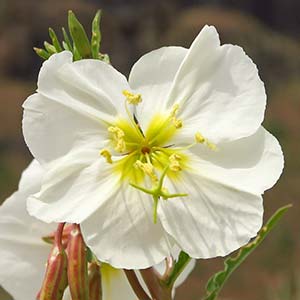Oenothera curtiflora
Oenothera pallida
lizard-tail, small-flower bee-blossom, small-flower gaura, velvet weed
mountain evening primrose, pale evening-primrose, rockweed brush, white-stem evening primrose
erect, unbranched or many-branched distally, (20–)30–200(–300) cm.
erect or ascending, single to several from base, unbranched or many-branched throughout, 10–50(–70) cm.
in a basal rosette and cauline, basal 4–15 × 1.5–3 cm, petiole 0–1.8 cm, blade broadly oblanceolate, margins sinuate-dentate to dentate;
cauline 2–13 × 0.5–5 cm, petiole 0–2 cm, blade narrowly elliptic to narrowly ovate, margins sinuate-dentate to dentate.
cauline, rosette usually weakly developed or absent, at least during flowering, sometimes well developed, 1–5(–7.8) × 0.3–1(–1.5) cm;
petiole 0–2(–4.5) cm;
blade lanceolate, oblong, linear-lanceolate, or ovate, margins subentire or remotely denticulate, deeply sinuate-dentate, or pinnatifid, sometimes repand.
relatively long, dense.
4-merous, nearly actinomorphic, opening near sunset;
floral tube 1.5–5 mm;
sepals 2–3.5 mm;
petals white, fading pale to dark pink, slightly unequal, oblong-obovate to elliptic-oblanceolate, 1.5–3 mm, abruptly clawed;
filaments 1.5–3 mm, anthers 0.5–1 mm, pollen 85–100% fertile;
style 3–9 mm, stigma surrounded by anthers at anthesis.
1–several opening per day near sunset;
buds nodding, weakly quadrangular, with free tips 0–2 mm;
floral tube 15–40 mm;
sepals 10–30 mm, not spotted;
petals white, fading pink to deep pink, broadly obovate or obcordate, (10–)15–25(–40) mm;
filaments 9–15 mm, anthers 3–10 mm;
style 25–55 mm, stigma exserted beyond anthers at anthesis.
fusiform, terete, weakly angled in distal 1/3, angles becoming broad and rounded in proximal part, 5–11 × 1.5–3 mm, tapering abruptly toward base;
sessile.
spreading to reflexed, straight to curved or contorted, cylindrical, obtusely 4-angled, tapering slightly from base to apex, 15–60 × 1.5–2.5 mm;
sessile.
3 or 4, reddish brown, 2–3 × 1–1.5 mm.
numerous, in 1 row per locule, brownish with dark spots or black, narrowly obovoid, 1.5–2.2 mm.
= 14.
Oenothera curtiflora
Oenothera pallida
Oenothera curtiflora is self-compatible and autogamous (P. H. Raven and D. P. Gregory 1972[1973]). Sometimes it is apparently a biennial. The species is native to grassland regions and open areas across much of interior North America. The full extent of its indigenous range is not clear and collections from the eastern half of the United States (Alabama, Florida, Georgia, Indiana, Massachusetts, and Tennessee) and California may be more recent introductions. Gaura mollis Nuttall ex Torrey 1827 is an isonym of G. mollis E. James 1822, a suppressed name.
(Discussion copyrighted by Flora of North America; reprinted with permission.)
Subspecies 4 (4 in the flora).
Oenothera pallida is a poorly understood species currently subdivided into four subspecies (W. L. Wagner et al. 2007) that differ largely in aspect, leaf division, capsule configuration, and pubescence. The variation pattern is rather complex with almost no diagnostic character uniformly distinguishing any one of the subspecies. Instead, each of the subspecies, which are mostly geographically separated although there is some level of overlap, have diagnostic suites of characters that maintain their linkage some of the time, but break down across the geographic area of each so that no single character uniquely identifies it. Each subspecies is characterized by leaf, pubescence, and, often, habit features. The issues with the integrity and intergradations of the subspecies are discussed below.
Oenothera pallida has been determined to be self-incompatible (W. L. Wagner et al. 2007), but K. E. Theiss et al. (2010) determined that although most populations of subsp. pallida are self-incompatible, one near Salt Lake City is self-compatible.
(Discussion copyrighted by Flora of North America; reprinted with permission.)
1. Herbs annual, sometimes perennial from a taproot, when perennial, sometimes with lateral roots producing adventitious shoots, strigillose throughout and villous distally, especially on flower parts. | subsp. trichocalyx |
1. Herbs perennial from a taproot and with lateral roots producing adventitious shoots, glabrous, strigillose, or sparsely villous. | → 2 |
2. Plants glabrous, sometimes strigillose, rarely sparsely villous; leaf blade margins usually subentire or remotely denticulate, rarely pinnatifid; capsules usually contorted to curved. | subsp. pallida |
2. Plants usually strigillose, rarely villous or glabrous; leaf blade margins shallowly sinuate-dentate or denticulate, or deeply sinuate-dentate to pinnatifid, rarely only dentate; capsules usually straight or curved, sometimes contorted. | → 3 |
3. Leaf blades (0.4–)0.7–1.5 cm wide, margins shallowly sinuate-dentate or denticulate. | subsp. latifolia |
3. Leaf blades 0.4–1(–1.5) cm wide, margins usually deeply sinuate-dentate to pinnatifid, rarely dentate only. | subsp. runcinata |
- Local floras:
BC,
CA,
OR,
WA
- Local Web sites:
CalFlora,
CalPhotos,
Flora NW,
Go Botany,
IL Wildflowers,
KS Wildflowers,
LA Plants,
MD Biodiversity,
MN Wildflowers,
MO Plants,
PNW Herbaria,
SW CO Wildflowers
WildflowerSearch
iNaturalist (observations)
USDA Plants Database
- LBJ Wildflower Center
- SEINet
- Plants of the World Online
- Encyclopedia of Life
- Wikipedia
- Google Image Search


